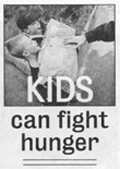By Pat Ford
Pew Center
 They had a deceptively simple goal, the team that produced The Charlotte Observer series “Hunger in the Land of Plenty.” They wanted to answer the question, “Why is there still hunger?”
They had a deceptively simple goal, the team that produced The Charlotte Observer series “Hunger in the Land of Plenty.” They wanted to answer the question, “Why is there still hunger?”
Editor Steve Gunn (then projects editor, now metro editor) says the question haunted him after driving a van full of homeless people to a shelter in the boom town of Charlotte, where unemployment was 2.4 percent. He enlisted Jeri Fischer Krentz, who covers non-profit agencies for The Observer. She teamed up with reporter Blair Robertson and photographer Patrick Schneider to get to the human turmoil at the bottom of Gunn’s question.
One thing the team knew from the beginning, though, was that it would be of no service to their readers to answer the question without giving them a way to respond. So all through the reporting process, Gunn and his reporters were assembling lists of things to do, agencies to call and ways to help.
When, three months later, a four-part series ran with incisive reporting about the conditions that cause hunger to persist even in good times and the human cost of those conditions, it also included a list of 14 things the well-fed could do to counteract those conditions.
- “Sort incoming and outgoing food supplies at Second Harvest Food Bank,” The Observer suggested, printing the food bank’s address and phone number.
- “Pick fruits and vegetables with the Society of St. Andrew, a group that oversees gleaning…crops that would otherwise be left in the fields and orchards.”
- “Donate canned goods and food staples to Charlotte Emergency Housing.” Knowing from experience that readers are often moved to donate money, The Observer provided an accounting of what various organizations could do with $20, $50, up to $500.
- “$20 will buy 30 meals for Kids Cafe, a soup kitchen for children,” Observer readers learned.
- “$50 will buy a hoe, trowel, watering can and garden hose for Charlotte Green, an organization that helps inner-city neighborhoods plant vegetable gardens.”
- “$83.60 will buy meals for one person for one month through Friendship Trays, an agency that delivers hot lunches to shut-ins and others.”
For those who wished to donate food directly, an information box told readers which foods would be most useful.
“The phones started ringing right away,” says Gunn, something he attributed to both a strong tradition of community service in the Charlotte area and the relationship the newspaper has with its readers.
“When we print a story saying someone needs help, people line up outside the door,” says Gunn. “Our goal is to be as connected to Charlotte as we can and to have people in Charlotte connected to us. If a relative called and said ‘your neighbor needs help,’ you’d respond. Well, it’s almost the same when The Observer tells you. We want that kind of relationship.”
One new idea in the Hunger project: The Observerpublished a list of things kids could do. On each day of the series, under the heading “Kids can fight hunger,” the paper printed ideas simple and appealing enough that even fairly young kids could accomplish.
For example, the paper suggested, “You could help at a potato drop. What’s a potato drop, you ask? Every once in a while, a truckload of potatoes will arrive at a potato chip factory and be judged fine for eating but unsuitable for chips. Rather than throw the shipment away, the factory manager calls the Society of St. Andrew. Sometimes the donated spuds get ‘dropped’ in a gigantic pile at a parking lot. Volunteers gather them up and distribute them.” The Society of St. Andrew’s phone number was again listed.
“I was very pleased with the response to that,” says reporter Krentz. “That was very successful. A lot of teachers called asking for reprints for their classrooms and I think a lot of families got involved that way.”
The Hunger project happened to be well-suited to a kid’s “to do” list. More general lists for helping readers connect to stories are “just a given” at The Observer, says Gunn. “That’s how we do things. We have a box for almost any occasion — a ‘how to help’ box, a ‘need more information’ box, a ‘want to go’ box. It’s so routine, it’s integrated into everything we do.”
Charlotte area non-profit agencies say they appreciated the boost in calls during the Hunger series. “I think one of the good things is they put a face on hunger,” says Beverly Howard, director of a feeding program called Loaves and Fishes. “We got calls about specific families that Jeri wrote about and as their needs were met, we could channel those offers of help into the more general need.”
Howard and others, though, say the series’ most valuable contribution was raising awareness of the problem. “The biggest difficulty in getting people to support hunger relief is having them understand that hunger really does exist in this land that is so prosperous,” says Becky Van Wie of the Second Harvest Food Bank. “For those of us blessed enough to be comfortable, it’s easy to deny this kind of need exists. That’s why these kinds of efforts are so valuable to us.”
Krentz, for her part, is happy that the series prompted readers to call and offer help but she worries that it was short on long-term solutions. “We had so many people calling and offering beds and clothes and food,” says Krentz. “But the agencies around here are still very busy and the line (for meals) at the Urban Ministry Center is still very long.”
